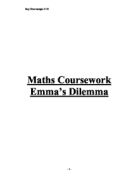From looking at the table I have noticed that if you times the number of letters in the word by the previous number of different arrangements then you result in the next quantity of different arrangements. Eg. 3,2
This suggests that the number of arrangements can be found out by the previous words. So…
3*2 =6
This shows a use of the factorial. The number of arrangements of 4 also ties in with this trend because… 4*3*2=24
In theory this means that a 5 letter word would have a possible 120 different arrangements. To see if this is correct I will test a 5 letter word.
…therefore 24*5=120 which matches the trend, so the prediction that I made was correct.
I have now made a table to show the total number of different arrangements for words with 3 letters up to words with 7 letters.
The table below shows the results I have collected and the number of different arrangements for a 5,6 and 7 letter word that I have predicted.
To write my equation so as to work out an x length word with no repeated letters I have formed an equation using letters to symbolise the various digits. A short version of the method I have used can be shown by this equation: n! = a
Where n = the number of letters in the word.
And a = the total number of re-arrangements possible.
! is a mathematical term meaning factorial. So 5! Is the same as 4*3*2, and 4! Is the same as 4*3*2. This is the method I have used, so to save time I have used the ! in stead of writing out the whole sum.
Some words have 2 letters or more the same such as...EMMA. I will now compare how having a repeated letter effects the total quantity of arrangements possible with these words, which have a repeated letter in. I would like to find out whether the same equation is correct for this or whether it must be modified in some way.
A 4 letter word with 1 repeat in…
A total of 12 different arrangements.
Having a repeated letter obviously does effect the total amount of different arrangements possible as in a 4-letter word with no repeats in there were 24 different arrangements whereas as with this repeated letter there are only half the amount,12. A word which contains 2 of the same letters has half the different arrangements of that with no repeats. In accordance to this a 3 length word with 1 repeated letter should have 3 different arrangements because this is half of the total of the same length word with no repeats.
NOO
ONO
OON
Total =The 3 letter word also follows this predicted trend.
I can now produce a table to show the predicted total amount of arrangements for any length word with 1 repeat in.
Table of Results
The table shows that the number of different arrangements of a word with 2 of the same letters is exactly half of that with no repeats in a word of the same length. To find the amount of varied arrangements of a word with 2 letters the same I have divided by 2 the answer to the same length word without a repeat. Following this it could be that to find the total amount of different arrangements of the same length word with 3 of the same letters I must divide by 3, as there are 3 letters the same.
Therefore for words with any number of the same letter in the equation is slightly different to previously... n!
P!
Where n is the number of letters in the word.
And p is the number of the same letters.
If this theory is accurate a 3 letter word with 3 of the same letters would only have 1 arrangement…
NNN
This does support my theory but I do not think it is sufficient evidence to support my theory I shall make a prediction for a longer word to act as further evidence in order to prove my theory.
I predict that a 4-letter word with 3 of the same letters in will have…
5!
3! = 20
Total = 20 different arrangements.
This means my theory is probably correct I can now produce a table showing what I think are the total amount of variations of a word with a repeated letter in.
The equation: n!
p!
…only works if there is just one letter repeated. So my equation would work to find out the total number of different arrangements for a combination like…mmab but not for mmbb…as this has 2 pairs of the same letters in. I can modify my equation slightly to account for this however…
n!
p!*m
Using this equation a 4-letter word with 2 letters repeated once should have 6 different arrangements…
My equation seems to work I have managed to predict the amount
arrangements , but to make sure I am not wrong I will try a 4- letter word letter word with 3 of the same letters in…
I predict this word will have a possible…
4!
3!*1 = 4 different arrangements
Total arrangements = 4
This is also more proof that my theory works so I can find the number of arrangements of any word with any number of repeats in using my final equation. I find this to be satisfactory evidence to more a less prove my theory correct. Therefore I have solved Emma’s dilemma and found out the formula.







